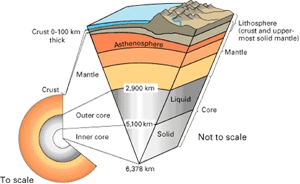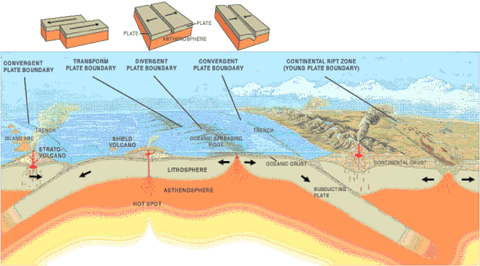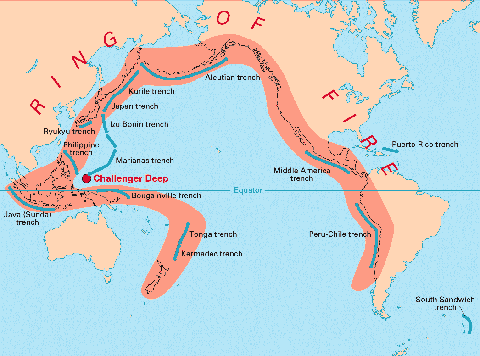 |
How
Volcanoes Work
A Little Background
 If you were to cut away a section of the Earth, you would
see layers. The uppermost layer is known as the lithosphere,
and includes the rocky parts of Earth’s surface. This
layer is up to 100 km (60 mi) deep and is divided into the crust
and upper mantle. The upper part of the crust is made of igneous,
sedimentary and metamorphic rocks; this makes up the continents.The
ocean floors are primarily made of igneous rocks covered with
sediments. Everything we are able to see directly from the Earth’s
surface is really the lithosphere: all rocks, soil, formations—even
deep canyons like the Grand Canyon or the Marianas Trench only
cut a few kilometers into the lithosphere.
If you were to cut away a section of the Earth, you would
see layers. The uppermost layer is known as the lithosphere,
and includes the rocky parts of Earth’s surface. This
layer is up to 100 km (60 mi) deep and is divided into the crust
and upper mantle. The upper part of the crust is made of igneous,
sedimentary and metamorphic rocks; this makes up the continents.The
ocean floors are primarily made of igneous rocks covered with
sediments. Everything we are able to see directly from the Earth’s
surface is really the lithosphere: all rocks, soil, formations—even
deep canyons like the Grand Canyon or the Marianas Trench only
cut a few kilometers into the lithosphere.
The remaining layers are known as the mantle
and the core. Rock material in the mantle exists in a state
which acts much like a solid but also flows like plastic putty
under pressure. The mantle helps to convect heat from the molten
outer core which is composed primarily of iron. In the inner
core, the iron has been compressed under intense gravity and
is so dense it is solid.
Rock Science
Igneous rocks form by the cooling and
crystallization of magma (molten rock below the surface)
or from lava (molten materials on the Earth's surface).
The amount and size of the minerals formed depends on
how fast the lava cools. Some lavas contain few minerals
and are composed mostly of volcanic glass.
Sedimentary rocks are comprised of
stones and clay, mineral grains and organic materials.
As solid rock is weathered it is broken down, transported
by wind, water or ice, and deposited either on land or
at sea. Sediment commonly starts out as soil. Think about
a handful of soil under a microscope. What you see are
very tiny particles of weathered rocks and decomposed
organic material from dead plants, animals and bacteria.
Over time, soils may be found to contain layers, with
each layer having a different chemical composition and
texture. Over much more time, under low heat and pressure,
the very small masses in the soil become solidified—compressed,
crystallized or cemented together to form sedimentary
rock layers.
|
Plates and hot spots
 Most
volcanoes exist at the boundaries of the enormous, rigid tectonic
“plates” that make up the Earth's lithosphere. These
plates move very, very slowly (a few centimeters a year) in
random directions over Earth's surface, “floating”
on the semi-liquid mantle. Plate movement is in response to
the changing conditions in the mantle, where the semi-liquid
rock material is convecting heat away from the outer core. Plate
movement is also responsible for causing earthquakes and forming
new mountain ridges. Most
volcanoes exist at the boundaries of the enormous, rigid tectonic
“plates” that make up the Earth's lithosphere. These
plates move very, very slowly (a few centimeters a year) in
random directions over Earth's surface, “floating”
on the semi-liquid mantle. Plate movement is in response to
the changing conditions in the mantle, where the semi-liquid
rock material is convecting heat away from the outer core. Plate
movement is also responsible for causing earthquakes and forming
new mountain ridges.
In some places the plates "crash"
into each other (converging), in other places they are drifting
apart (diverging), and in still other places they grind and
slide past each other like two cars sideswiping each other.
(See Illustration below)

Close to eighty percent of the volcanoes on
large bodies of land are found where two tectonic plates converge
and one of the plates is forced downward into the hot mantle.
When this happens, the temperature and pressure increases, eventually
causing some of the rocks in the plate to melt and form magma.
The magma formed in these regions, called subduction
zones, makes its way to the surface and forms volcanoes.
Where subduction occurs under a continent,
a string of volcanoes may form inland over the top of the subduction
zone. The Cascade volcanoes in the American northwest are an
example. Where subduction occurs in oceanic regions, a volcanic
island arc forms. The islands of Japan and the Aleutian Islands
are examples. A vast circle of volcanic activity, nicknamed
the "ring of fire," surrounds the Pacific plate where
it subducts under Asia, Australia, and the Americas. A subduction
zone at the eastern end of the Caribbean Sea gave rise to the
volcanoes that formed the Lesser Antilles, including the island
of Martinique. (See the “Puerto Rico Trench in the illustration
below.) You may recall the earlier illustration
which showed the volcanic ridges in the Caribbean formed by
the North American plate converging on the Caribbean plate and
sliding underneath to create a subduction zone.

Answer: They are both located in the
Pacific "ring of fire."
Question: What does Mount St. Helens
in the Northwestern United States, which erupted in 1980,
have in common with Mount Pinatubo on Luzon Island in
the Philippines, which erupted in 1991?
|
A few volcanoes occur on top of "hot
spots" far from the edges of plates. In these spots, columns
of hot material from the crust and mantle convect upwards and
"burn through" the surface to form volcanoes. As continental
plates move over hot spots, the hot material periodically burns
through the plate to form a new volcano. The result is a chain
of progressively older volcanoes marking the direction of the
movement of the plate over the hot spot. The Hawaiian Islands
and the geyser activity of Yellowstone National Park were formed
in this way.
Of gas and viscosity
When a once sleeping volcano returns to life,
the first signs of awakening are often clusters of small earthquakes.
These tremors are caused by the magma forcing its way upwards
into crevices, cracking the brittle surface rocks, and shoving
them aside. Whether there are explosions or slow releases of
lava over time depends mostly on two factors: the magma's "viscosity,"
and the amount of dissolved gases in it. If the viscosity is
low, or syrupy, due to lower amounts of silica, the magma flows
quickly downhill and forms runny lava flows. If the viscosity
is high like toothpaste, due to higher amounts of silica, the
magma oozes slowly onto the surface and forms a thick, stubby
dome. If the magma contains large amounts of dissolved gases,
like steam, the volcano erupts like a bottle of carbonated soda
that has been shaken and opened quickly. As the gas-charged
magma nears the surface, the pressure drops, and the gas comes
out of the super-heated liquid in the form of bubbles that expand
so rapidly they create explosions.
Scientists use the word "effusive"
to describe volcanoes with flowing magma. The gassy, explosive
volcanoes are described as, you guessed it, "explosive."
Now, that's hot...
The hottest recorded temperature for magma is a beyond-blistering
1,200 °C. (2,200 degrees Fahrenheit). |

Review Questions
- How would a scientist explain the presence of sedimentary
rock in the Earth's mantle? What does this have to do with
subduction?
- Tectonic plates move very, very slowly. Explain why they
move.
- Explain how the eruption of molten rock onto Earth's surface
is part of the rock cycle.
|
 |